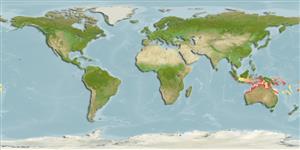>
Eupercaria/misc (Various families in series Eupercaria) >
Lethrinidae (Emperors or scavengers) > Lethrininae
Etymology: Lethrinus: Greek, lethrinia, a fish pertaining to genus Pagellus.
More on authors: Alleyne & Macleay.
Environment: milieu / climate zone / depth range / distribution range
Ecologie
marien; brak water rifbewoner; standvastig; diepte 5 - 35 m (Ref. 90102). Tropical; 3°S - 23°S
Western Pacific: southern Indonesia, northern Australia, Papua New Guinea and the Solomon Islands. There has been considerable confusion in the use of names for this species. In recent literature it is referred to as Lethrinus fraenatus (a junior synonym of Lethrinus nebulosus) or Lethrinus fletus (a junior synonym of Lethrinus laticaudis).
Grootte / Gewicht / Leeftijd
Maturity: Lm ? range ? - ? cm
Max length : 56.0 cm TL mannelijk / geslacht onbekend; (Ref. 2295); common length : 35.0 cm TL mannelijk / geslacht onbekend; (Ref. 2295)
Dorsale stekels (totaal) : 10; Dorsale zachte stralen (totaal) : 9; Anale stekels: 3; Anale zachte stralen: 8. Cheek without scales; the inner base of pectoral fins densely covered with scales. Body is tan, brown or yellow with scattered irregular blotches; head brown or yellow with blue dots on cheeks and short blue stripes radiating in front and behind the eye, sometimes a number of blue cross stripes between the eyes; fines pale or yellow, the vertical fins are mottled.
Juveniles found in seagrass beds and mangrove swamps. Adults found over coral reefs. Often in schools (Ref. 9710). Feeds mainly on crustaceans and fishes. Considered a good food fish. Marketed fresh (Ref. 9775).
Levenscyclus en paargedrag
Maturiteit | Voortplanting | Paaien | Eieren | Fecunditeit | Larven
Carpenter, K.E. and G.R. Allen, 1989. FAO Species Catalogue. Vol. 9. Emperor fishes and large-eye breams of the world (family Lethrinidae). An annotated and illustrated catalogue of lethrinid species known to date. FAO Fish. Synop. 125(9):118 p. Rome: FAO. (Ref. 2295)
Status op de Rode Lijst van het IUCN (Ref. 130435: Version 2024-1)
Gevaar voor de mens
Harmless
Gebruik door de mens
Visserij: commercieel; sportvis: ja
Tools
Speciale rapporten
Download XML
Internetbronnen
Estimates based on models
Preferred temperature (Ref.
123201): 26.3 - 28.8, mean 27.7 °C (based on 242 cells).
Fylogenetische diversiteitsindex (Ref.
82804): PD
50 = 0.5000 [Uniqueness, from 0.5 = low to 2.0 = high].
Bayesian length-weight: a=0.01479 (0.00699 - 0.03129), b=2.98 (2.81 - 3.15), in cm total length, based on LWR estimates for this Genus-body shape (Ref.
93245).
Trofisch niveau (Ref.
69278): 4.5 ±0.8 se; based on diet studies.
Weerstandsvermogen (Ref.
120179): Gemiddeld, minimale populatieverdubbelingstijd 1,4-4,4 jaar (Preliminary K or Fecundity.).
Fishing Vulnerability (Ref.
59153): Moderate vulnerability (42 of 100).
Nutrients (Ref.
124155): Calcium = 36.6 [23.6, 61.2] mg/100g; Iron = 0.797 [0.506, 1.323] mg/100g; Protein = 20.6 [18.0, 22.8] %; Omega3 = 0.139 [0.091, 0.215] g/100g; Selenium = 33.4 [18.0, 60.4] μg/100g; VitaminA = 54.5 [11.0, 309.5] μg/100g; Zinc = 1.93 [1.34, 2.67] mg/100g (wet weight);
